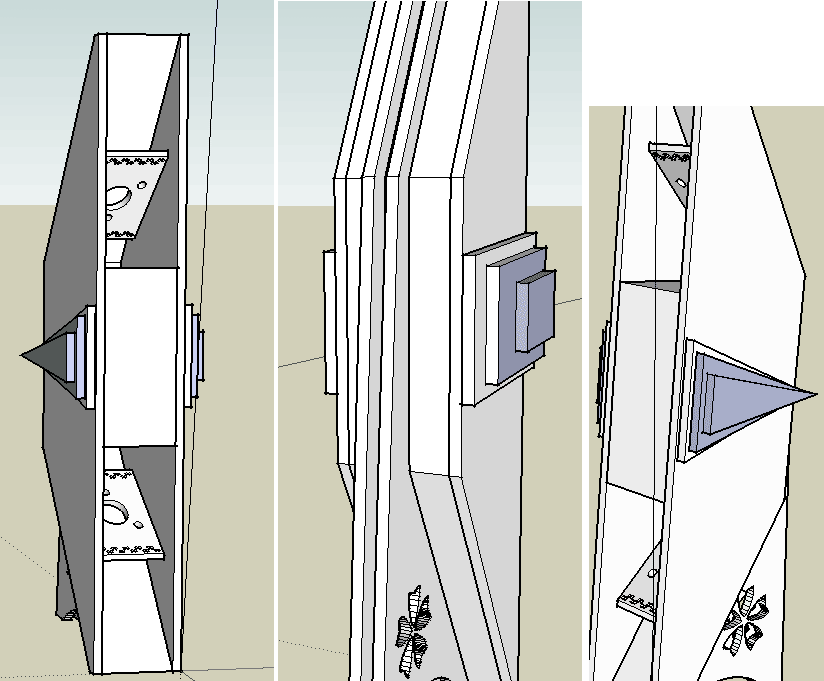Dave is actually (forgive me) only partially correct. Cavity volume is indeed critical, but the proportions can in fact affect the details of behavior, less intuitively than many might expect, so I would actually go easy in this regard. Rectilinear form factors are not necessarily a bad thing, acoustically -it depends on their dimensions, and you'll recall that higher frequencies are rather more easily addressed than lower; with the small dimensions of an air cavity, relatively minor amounts of a decent damping material will kill what eigenmodes exist. In this case QRD type diffusers are OK so long as some damping is present, and there is not a dramatic shift in the average z axis location of the chamber rear panel.
Bottom end of these type of diffusers is established by well depth.. Keeping equal void volume behind the driver to the design would be ~1100 Hz with 15 cm max well depth.. There is a great calculator link posted above.. I looked at having these 3D printed but at $750 EACH in ABS, so using off-cuts for me it was.Now I see this, I wish I did the same with my Victors I recently builded, but it's too late... Will be added to my next build for sure.
I could use my 3d printer and fill the print with foam or concrete.
What is the best diffuser frequencies to choose for ? Is 2k as start freq not on the high side?
I've one question. Is it possible to use Ikea's Blanda Matt as a speaker chamber ( https://www.ikea.com/gb/en/p/blanda-matt-serving-bowl-bamboo-20214340/ ) and then have a flat panel behind the speaker as a first part of the dual horn?
This could permit to use the full volume behind with a single horizontal panel dividing the two horns, and prolong a bit the lenght of the horn itself, or shorten the height of the speaker.
What would it be the sonic impact of this?
Thanks,
Roberto
Any specific experience or guidelines on baffle width? Specifically beveling the baffle edges @ 45 to minimize edge-diffraction or in an even more creative form scalping the edges at 45 to narrow the baffle at / around the driver?

I am not sure quite what you are trying to illustrate, but a general rule is to keep the inner walls away from the back of the driver as much as possible.
dave
dave
Yes, I see how that wasn't totally clear. I was thinking of scalloping the front baffle only with a 45 degree router bit and curved-template and not modifying the sidewalls which remain as designed. I have built the baffle at 28mm so there is more than enough mass to "carve into" with compromising glue-up to the side-walls.I am not sure quite what you are trying to illustrate, but a general rule is to keep the inner walls away from the back of the driver as much as possible.
dave
Last edited:
I don’t think that would hurt at all. A full depth ellipoidal supreBaffle would take the same idea further.
dave
dave
That sounds like a different spelling of, “get a CNC for science”I don’t think that would hurt at all. A full depth ellipoidal supreBaffle would take the same idea further.
dave
What is the sonic benefit of having two horns "in parallel" like in this design, versus a single one?
Thanks
Thanks
You get a loudspeaker with a smaller footprint.
These are all inspired originaly by the C&C loudspeakers.
Scott and i have been plating a bit with designs that have a fat version and a tall version.
dave
These are all inspired originaly by the C&C loudspeakers.
Scott and i have been plating a bit with designs that have a fat version and a tall version.
dave
Taller gives improvements because the total area of the horn is double and at the same time the arc behind the loudspeaker is wider?
The horn does not change size, just shape. Mouth is the same, just twice as wide and half as tall.
Imagine cutting the box in half and flipping the top half so that it sits beside the other half and then merge them and tidy up.
dave
Imagine cutting the box in half and flipping the top half so that it sits beside the other half and then merge them and tidy up.
dave
Sorry, my post wasn't clear. I meant: if I mirror a second horn in parallel with the first one, on top of the first one, total area of the output of the horn is twice, and the arc behind the loudspeaker is twice as wide. Is this giving a plus to the sound?
Pass. That isn't how they're actually designed (at least, it isn't how I design them -Dave was imply giving you a visual analogy), so assuming you started with a well-optimised horn in the first place, you'll significantly change the loading characteristics by simply mirroring one.
Doubling the width of the horn would need 2 drivers. Similar is done, but vertically with the double Frugel-Horns.
dave
dave
- Home
- Loudspeakers
- Full Range
- A Silbury Build
